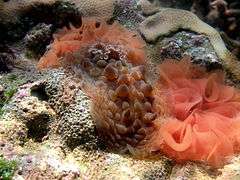Asteronotus cespitosus
| Asteronotus cespitosus | |
|---|---|
 | |
| Asteronotus cespitosus | |
| Scientific classification | |
| Kingdom: | Animalia |
| Phylum: | Mollusca |
| Class: | Gastropoda |
| (unranked): | clade Heterobranchia clade Euthyneura clade Nudipleura clade Nudibranchia |
| Superfamily: | Doridoidea |
| Family: | Discodorididae |
| Genus: | Asteronotus |
| Species: | A. cespitosus |
| Binomial name | |
| Asteronotus cespitosus van Hasselt, 1824[1] | |
| Synonyms | |
| |
Asteronotus cespitosus is a species of sea slug or dorid nudibranch, a marine gastropod mollusk in the family Discodorididae.[2]
Distribution
This is a widespread Indo-West Pacific marine species which occurs in the Red Sea and from the Indian Ocean coasts of Tanzania, Madagascar, Seychelles and Mauritius to Indonesia, the Philippines, New Guinea, Australia and out into the Pacific Ocean as far as Hawaii and Japan.[3]
Description
The body of this nudibranch grows to a length of 250 mm. It is distinctive, with ridges of large tubercles running down centre of body, and a series of tubercles running parallel to the margin. The body is firm leathery. Its colour varies from blackish grey to brown, with paler tubercles and patches of white. This provides the species with camouflage well suited to its preferred habitat. The egg ribbon, in contrast, is pink. [2]
Ecology
Asteronotus cespitosus feeds on sponges.
References
- ↑ Hasselt, J.C. van (1824). Uittreksel mit einen brief van Dr J.C. Hasselt, aan Prof van Swinderen. Algemene Konst-en Letterbode 1824 2: 20–24
- 1 2 Bouchet, P. (2016). Asteronotus cespitosus (van Hasselt, 1824). In: MolluscaBase (2015). Accessed through: World Register of Marine Species on 2016-10-24.
- ↑ Gosliner T.M., Behrens D.W. & Valdés A. (2008) Indo-Pacific nudibranchs and sea slugs. Sea Challengers Natural History Books and California Academy of Sciences. 426 pp., page 173.
- Allan, J.K. 1932. Australian nudibranchs. The Australian Zoologist 7(2): 87–105
- Wells, F.E. & Bryce, C.W. 1993. Sea Slugs of Western Australia. Perth : Western Australian Museum 184 pp.
- Marshall, J.G. & Willan, R.C. 1999. Nudibranchs of Heron Island, Great Barrier Reef. Leiden : Backhuys 257 pp.